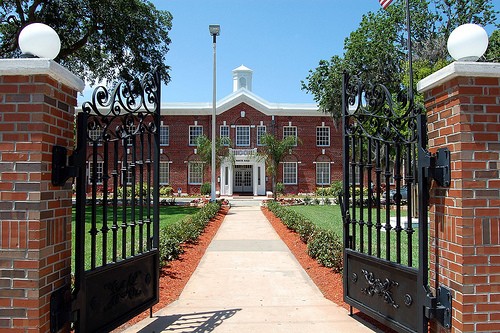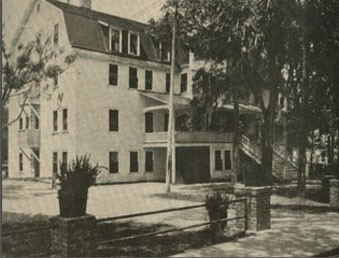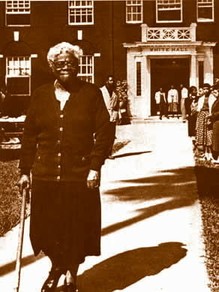Bethune-Cookman University
Introduction
Text-to-speech Audio
Images
Bethune-Cookman University

Bethune-Cookman University

Mary McLeod Bethune

Backstory and Context
Text-to-speech Audio
Bethune-Cookman University was founded by none other than Dr. Mary McLeod Bethune in 1904. This University sits along Florida’s east coast in the city of Daytona Beach and has expanded through its community over the last 100 years. It began as the Daytona Educational and Industrial Training School for Negro Girls and abbreviated as B-CC for short. From there, with the guidance of Mary McLeod Bethune the school had grown and has now become a thriving place of education.
Mary McLeod Bethune was an important figure in the 20th century as an educator, a civil rights activist, and founder of Bethune Cookman. All her life she strived to learn and her mission became finding ways to provide higher education to the Black community. She was born in Maynesville, South Carolina where she as a young child and as a daughter of former slaves had the opportunity to receive an education. Being distinguished early on in her academics she was able to further her education and won scholarships in the process (Dabel). Her experience with these programs motivated her to spread the word and open up new and exciting opportunities for other fellow African Americans. She is also recognized for her work with President Herbert Hoover and even served alongside in his cabinet.
Now over more than 100 years old the campus remains active in Daytona Beach with more students enrolled now than ever before. As mentioned before, the school was initially the Daytona Educational and Industrial Training School for Negro Girls. Here it began its early days with a budget of $1.50 and 5 female students. During one evening in 1920, the Ku-Klux Klan had encircled the campus with hopes of tormenting the young girls, but the girls and Bethune were able to drive them away by remaining unbothered as they gathered outside and sang spirituals (Kashif). Soon after in 1923, Bethune had merged her school along with the Darnell Cookman Institute for boys, thus making it more familiar to its modern coeducational environment we know today. Here is where it was renamed as Bethune Cookman. Bethune served as president from 1923 to 1942 and once again from 1946 to 1947 (Dabel). Due to her involvement among several other matters such as women’s politics, civil rights, and belonging to several other Organizations she was only able to take on the role of president for so long. She founded a school during the post slavery era in which African Americans were learning for the first time how to enrich their own lives and live in freedom. However, they weren’t completely free.
During the Early years of Bethune Cookman it gave young students and adult learners a place to advance themselves academically and socially by providing higher education that can propel them to live better lives. Not only through knowledge would that happen, but through programs and a sense of community that would motivate many for years to come. After a decade, the school reached Junior College accreditation and by 1941 Bethune Cookman College could offer its student body state-accredited baccalaureate programs (Kashif). Decades later the school now has 3,000 students enrolled and offers degrees from Education to Nursing and everything in between. Finally, in 2007 Bethune Cookman College was able to have its name upgraded to the well-known Bethune Cookman University.
This school came to be during a very difficult time for African Americans. When Mary McLeod opened this school back in 1904 it was a time where Jim-crow segregation still existed. Bethune combatted these issues her whole career until she passed away on May 18th, 1955 where she suffered a heart attack. She left a legacy, one that believed in equality, and that African Americans will better their existence in society through education (Bethune). Until the U.S. Supreme Court's Brown v. Board of Education decision in 1954, both public and private Black colleges in the South and in Florida had remained segregated by law and were the only educational option for African Americans (Gasman). It was a struggle, but with the introduction of Bethune Cookman University, hundreds of African American students in the Eastern Florida community were able to receive a quality education thanks to the work of Dr. Mary McLeod Bethune.
Today, you can visit the campus and its several buildings, and you can even visit the home of Mary McLeod Bethune that serves as a museum now of days. She gifted the building to the school as part of her last will and testament (Kashif). The University is home to a plethora of activities, extracurriculars, and programs to enrich its students as well. Some of those included are a thriving HBCU football program, Honor societies, and even their notorious university band program called the Marching Wildcats which has been seen on several talk shows and even the movie Drumline (2002). The legacy of Mary McLeod Bethune lives on the foundation she left for thousands of young students being able to have access to a higher education.
When Mary McLeod Bethune first established Bethune-Cookman University it was just known as the Daytona Literary and Industrial Training School for Negro Girls. She started the school having only $1.50 to do so. During Bethune’s existence, it experienced several changes and in 1919 the Daytona Educational and Industrial Institute was renamed Daytona Normal and Industrial Institute. It then joined Cookman Institute in Jacksonville, Florida in 1923 and became a school for both boys and girls. It also joined with the United Methodist Church at the same time. It was not until 27 April 1931 that the school became Bethune-Cookman College; it was given this name to honor the service of Bethune herself.
In 1936, Bethune was named as a central helper for Negro Affairs-her role being switched to Director of the Division of Negro Affairs in 1939-of the National Youth Administration. This was historic due to there being no other African American women leading a national company ever before in history. This is important because it lead to long sought federal money being sent to the college. While fulfilling this job, Bethune named Abram L. Simpson as president from 1937 to 1939. The college gained a 4 year baccalaureate curriculum after the Florida State Department of Education gave the okay for it in 1941. This allowed for the learning of liberal arts and teacher education.
Between 1942 and 1946, under James E. Colston’s presidency, the college joined the United Negro College Fund that was made by Bethune and Frederick Patterson in 1943. Colston also hired more staff and around 1945 and 1946 the staff went from including 9 people when he first became president, to including 23 people. Under Richard V. Moore Sr.’s presidency from 1947 and 1975 a great number of scholarly curriculums were added for students at the college making more majors in music, physical education, pre-medicine, pre-dental, and pre-pharmacy just throughout 1947. The college obtained complete recognition by the SACS in 1960. There were several structures that were built and remodeled; one of these was the Carl Southwick Swisher Library that was made and credited during the 1970-1971 classes. In August 2004 Trudie Kibbe Reed, Ed.D. became the president, making it the first time since Mary McLeod Bethune was president that a woman held this position. During her presidency, the college created its pioneer Master’s curriculum and gained university recognition in 2007. From 1943 to now, the university has seen over 13, 200 graduates. Its sports and music curriculums have gained notice throughout the country. Many of the students who have graduated here have jobs in a variety of working environments.1
Sources
Bethune, Mary. "Mary McLeod Bethune: 'Certain Unalienable Rights' (1944)."The American Mosaic: The African American Experience, ABC-CLIO. 2019.
Dabel, Jane E. "Mary Mcleod Bethune." The American Mosaic: The African American Experience, ABC-CLIO. 2019.
Gasman, Marybeth. "Historically Black Colleges and Universities." The American Mosaic: The African American Experience, ABC-CLIO.2019.
Kashif, Annette I. "Bethune-Cookman University." The American Mosaic: The African American Experience, ABC-CLIO. 2019.
